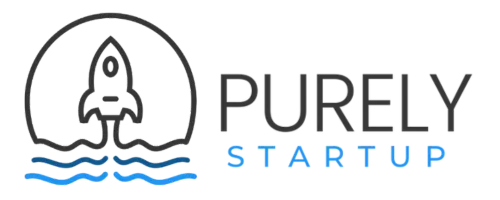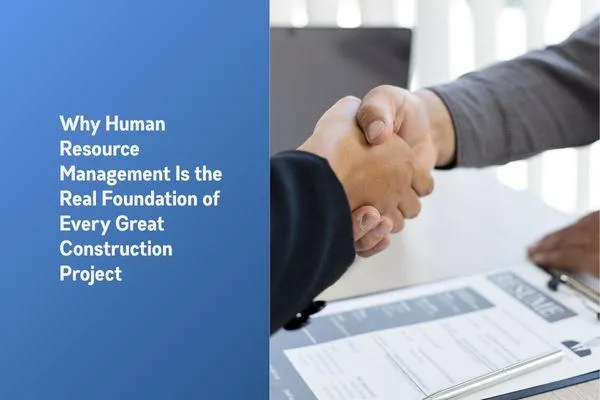
Why Human Resource Management Is the Real Foundation of Every Great Construction Project
Most construction leaders focus on materials, equipment, and meeting deadlines. But often, the real challenge is human resource management in the construction industry.
Labour shortages, poor onboarding, high turnover, and compliance issues quietly impact budgets and delay projects. HR in construction isn’t just about hiring; it includes workforce planning, safety training, legal compliance, and building strong teams that work well together on-site.
When HR is overlooked, mistakes increase, timelines slip, and productivity drops. But with the right HR systems in place, designed for the fast-paced, high-risk nature of construction, you gain stability, retain talent, and keep projects moving forward.
This blog post will explain why HR is critical to construction success and how to implement it effectively.
Why Human Resource Management Is the Real Foundation of Every Great Construction Project
What Makes HR in the Construction Industry So Necessary?
What Are the 7 Key Responsibilities of HR in Construction?
1. Recruitment & Workforce Planning
2. Compliance & Legal Risk Management
3. Site-Specific Onboarding & Training
4. Payroll, Shifts & Timekeeping
6. Conflict Resolution & Labour Relations
7. Diversity, Equity & Inclusion (DEI)
How Does Strategic HRM Improve Construction Project Outcomes?
Linking HR Metrics to Construction KPIs
How HR Helps Reduce Absenteeism, Improve Timelines, and Avoid Fines
Why Safety and Compliance Begin With HR
Can Small Construction Firms Build an HR Department Without Breaking the Bank?
How Is Human Resource Management Evolving in the Construction Industry?
Automation & AI in workforce planning
Mobile onboarding for field workers
Predictive hiring using HR analytics
What Makes HR in the Construction Industry So Necessary?
Managing people in construction isn’t like managing teams in a typical office setting. It’s fast-paced, project-based, and deadline-driven. Teams are assembled for a single job and then disbanded once it’s complete, which makes workforce planning, retention, and compliance far more complex.
Construction HR deals with a unique mix: temporary labour, subcontractors, union negotiations, safety protocols, and site-specific risks, all unfolding at the same time. This makes the human resource management in the construction industry more than just an administrative task. It’s a critical function that directly influences whether a project stays on schedule, on budget, and incident-free.
Learn how AI is changing the recruitment dynamics of HR in the construction industry.
What Are the 7 Key Responsibilities of HR in Construction?
In construction, you don’t get second chances. Crews hit the ground running, deadlines are tight, and one misstep can throw everything off. That’s why HR in the construction industry isn’t stuck behind a desk; it’s right there on-site, woven into the daily rhythm of the build.
From day one, HR is responsible for getting the right people through the gate, making sure they’re trained, paid, protected, and ready to work as a team. It’s more than paperwork. It’s the foundation that keeps everything else moving.
Below are seven core responsibilities of human resource management in the construction Industry, each one designed to prevent delays, cut down on confusion, and turn scattered crews into cohesive, high-performing teams.
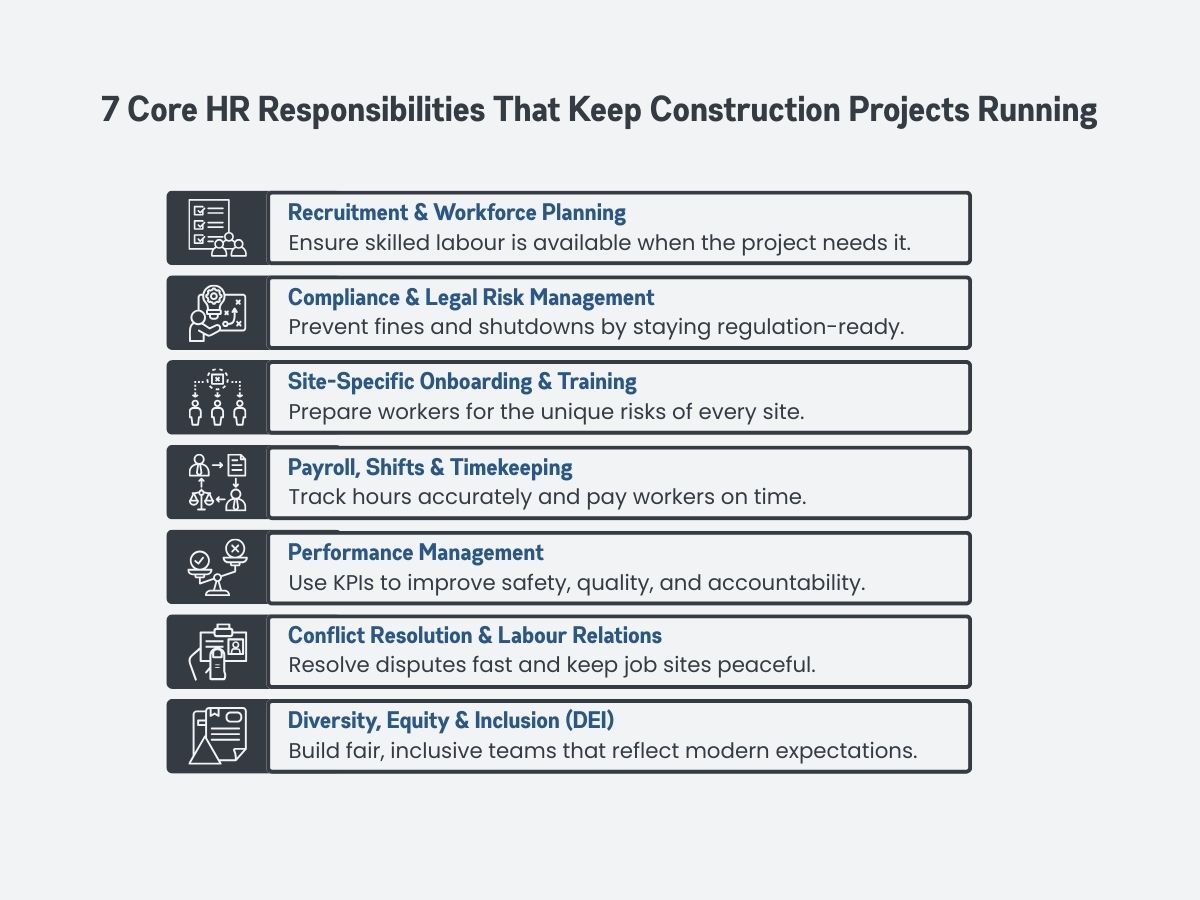
1. Recruitment & Workforce Planning
The workflow of construction projects is highly dependent on labour availability. If there is no crane operator, welder, or formwork specialist, then nothing moves. Therefore, strategic recruitment should encompass labour demand forecasting for every project phase, not just reactive hiring.
To stay competitive, HR must build talent pipelines, manage vendor relationships, and use labour forecasting software. Proactive human resource management in the construction Industry guarantees that skilled teams are present whenever they are required by a project, rather than waiting two weeks.
2. Compliance & Legal Risk Management
The construction industry is highly regulated, with working hours, safety certification, visa, and insurance being among them. The HR unit upholds compliance regulations through thorough documentation, periodic auditing, and upskilling.
For example, in the UK, HR professionals must discuss the roles and responsibilities of human resources commonly used in UK construction projects, especially around HSE standards and the Construction Regulations 2015. A single mistake in these rules can cost the loss of a whole project or huge fines.
3. Site-Specific Onboarding & Training
The two construction sites can never be similar. Terrain, safety concerns, tools, and emergency procedures are all different for every construction site. You just can’t put general onboarding for all.
An efficient HR team develops a customised site onboarding, which contains:
PPE training and fitting
Emergency evacuation drills
Hazard awareness sessions
Equipment usage instruction
Most firms maintain an HR policy for construction companies, filetype pdf, that is based on the frameworks offered by CIOB or AGC, to standardise onboarding and keep it specific to every site.
4. Payroll, Shifts & Timekeeping
Construction teams work in different shifts, at other times, and in various locations, unlike office-based workers. This makes payroll and attendance monitoring very difficult for the construction workers.
HR departments handle:
Shift planning
Overtime and hazard pay calculation
Leave and absence logging
Mobile apps with GPS use are now common among construction firms for clocking workers' time and approving shifts.
To HR, it's not just about paying people; it's about keeping well-documented records that stand up to audits. Timekeeping accuracy also assists human resource management in the construction Industry by aligning workforce costs with project budgets.
5. Performance Management
Must check the performance of construction beyond just productivity; go to check its safety behaviour, being on time, and teamwork. Field supervisors assess workers, but HR defines the framework.
Key performance indicators (KPIs) may include:
The review of performance leads to promotions, training needs, or even termination. So, accountability is the key; it keeps a sense of responsibility in every worker about their work. Efficient human resource management in the construction industry uses these reviews to design teams and deliver successful project outcomes.
It also helps you become a specialized construction management recruiter for various construction projects.
6. Conflict Resolution & Labour Relations
Construction sites can be challenging to handle. Tight deadlines, safety concerns, and different team backgrounds can sometimes lead to disagreements. HR acts as a mediator to resolve the problems quickly.
Here’s how HR deals with conflicts:
Clear grievance channels
Mediation training for supervisors
Union relationship management
In areas with strong unions, HR also handles group negotiations with workers. If things go wrong, it results in immediate action and asking to take a few days or weeks off work. This is the reason why knowing hr meaning in construction is essential. It ensures pleasant relationships between workers and unions.
7. Diversity, Equity & Inclusion (DEI)
Historically, construction has lacked diversity. But things are changing. Governments and public clients now require DEI reporting as part of tender submissions.
HR leads this charge through:
Inclusive recruitment strategies
Anti-bias training
Tracking gender, age, and ethnic representation
According to AIHR, HR policy, around 51% of workers say their employer has specific rules on how to use social media at work, while 63% oppose it and say there are no rules for the use of the internet at work.
Similarly, the AGC states that creating a more diverse and inclusive workplace not only helps construction companies find and retain skilled workers but also enables them to be better positioned for sustainable growth, have stronger teams, and meet national infrastructure goals.
Companies are learning that DEI (Diversity, Equity, and Inclusion) is not merely about following rules; it allows teams to work together and maintains a good standard of the company. Human Resource Management in the Construction Industry plays a significant role in making DEI a part of everyday work on-site.
How Does Strategic HRM Improve Construction Project Outcomes?
Strategic HR aligns talent with timelines. If the right people aren’t hired, trained, and retained, projects suffer. That’s why human resource management in the construction industry is directly tied to project KPIs.
According to McKinsey, improving workforce productivity in construction could boost industry value by $1.6 trillion globally, showing how better HR planning can drive significant gains.
Linking HR Metrics to Construction KPIs
These metrics show how an underperforming HR function can lead to missed deadlines, budget overruns, or even legal violations.
How HR Helps Reduce Absenteeism, Improve Timelines, and Avoid Fines
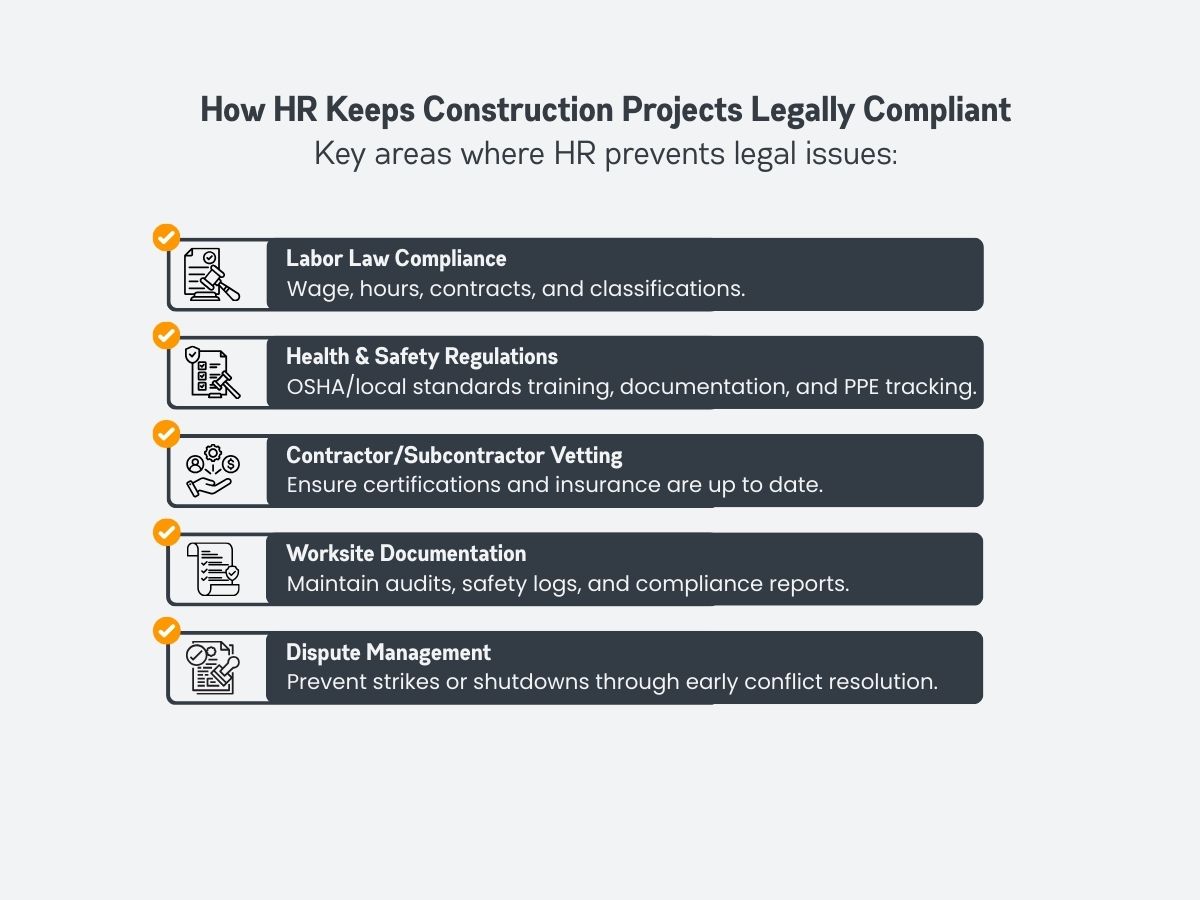
HR reduces absenteeism by improving worker engagement, enforcing clear attendance policies, and ensuring labour readiness, which directly enhances project timelines and lowers the risk of costly fines. When a key worker doesn’t show up, entire crews stall, materials sit unused, and schedules slip. A sound HR systems prevent this chain reaction before it starts.
Here’s how effective HR tackles it:
Monitoring trends and absence reasons: HR tracks patterns (e.g., site conditions, burnout) and addresses root causes before they impact productivity.
Offering attendance incentives: Bonuses, recognition, or even flexible shifts can motivate workers to show up reliably.
Streamlining sick leave and return-to-work policies: Clear, fair systems help prevent abuse while supporting genuinely ill workers.
Maintaining strong worker communication: Regular check-ins help HR stay ahead of morale dips and potential walk-offs.
With better planning and communication, construction HR jobs are evolving to become timeline guardians, not just admin roles. Moreover, the role of AI in HR dynamics can’t be ignored. Want to know more about it? Click here to see the best practices for implementing AI in the recruitment process.
Why Safety and Compliance Begin With HR
Most people assume site safety is the supervisor’s job. But it begins with HR, before workers even reach the gate.
HR is responsible for:
Ensuring all workers are trained
Keeping certification records up to date
Conducting safety orientation
According to OSHA and the HSE UK, human error is the leading cause of on-site incidents, many of which could be prevented by better onboarding and documentation.
Can Small Construction Firms Build an HR Department Without Breaking the Bank?
Yes, and they must.
Contractors of small and medium-sized firms often assume that HR only belongs to big firms. They feel it's only the need of large firms, but the reality is opposite. Absence of HR can lead to mismanagement of work, disorganised teams, delays of work, and ultimately the loss of the company’s reputation.
Affordable solutions include:
Outsourcing HR services
Using HR software-as-a-service (SaaS)
Hiring a part-time HR generalist
Even basic human resource management in the construction industry can drastically reduce risk and improve productivity. Human resource management roles and responsibilities in construction projects vary, but are always beneficial.
How Is Human Resource Management Evolving in the Construction Industry?
The future of HR in construction lies in the use of technology, thoughtful planning, and a big focus on sustainability. With fast-performing projects, HR is going to be a major assistant in managing teams, staying compliant, and finding better ways to work. It's all about using technology, smart planning, and focusing on sustainability.
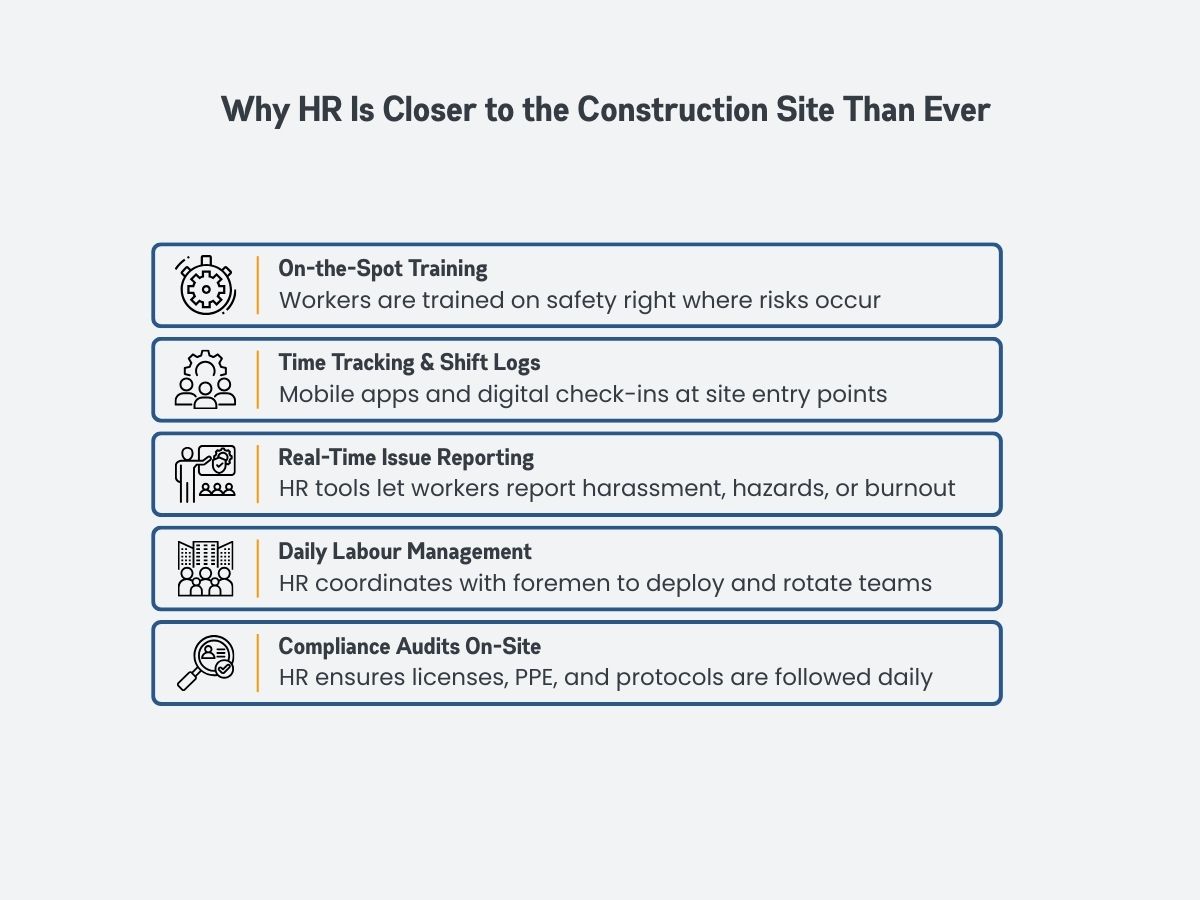
Here’s how the future is shaping up:
Automation & AI in workforce planning
Innovative tools now forecast skill shortages before they happen and help HR teams plan staffing with precision. This reduces last-minute hiring and improves cost control.
Mobile onboarding for field workers
Traditional paperwork is being replaced by app-based onboarding. Workers complete safety training, upload IDs, and sign documents from their phones even before stepping on site.
Predictive hiring using HR analytics
Construction HR utilises data trends to predict potential labour shortages based on project timelines or historical data, enabling proactive hiring efforts.
Green construction workforce strategy
Companies are employing individuals with sustainability expertise (e.g., energy-efficient systems, eco-friendly materials) to achieve environmentally conscious construction objectives.
ESG reporting and compliance
With ESG frameworks becoming standard, HR now manages key data on training, safety, and DEI.
Final Word from Purely Startup
As construction projects grow more complex, the key to staying ahead is blending human expertise with innovative AI tools, and that’s precisely what PurelyStartup offers.
By integrating strategic HR management with AI-driven planning, we help streamline hiring, training, compliance, and workforce tracking. This results in faster builds, fewer delays, and teams that just work. Want to see how it fits your project? Book a free call with PurelyStartup today.
